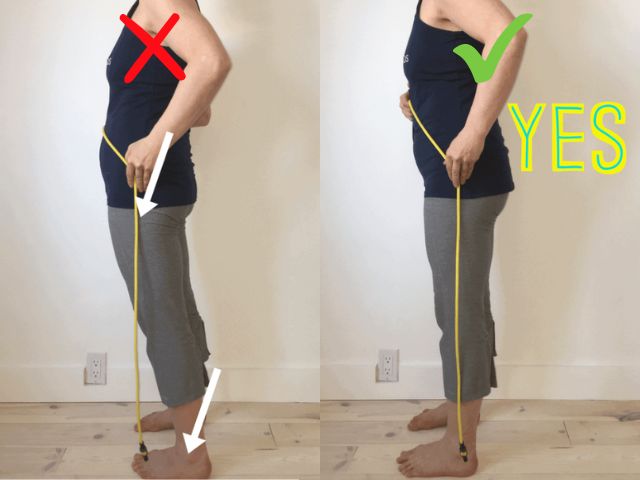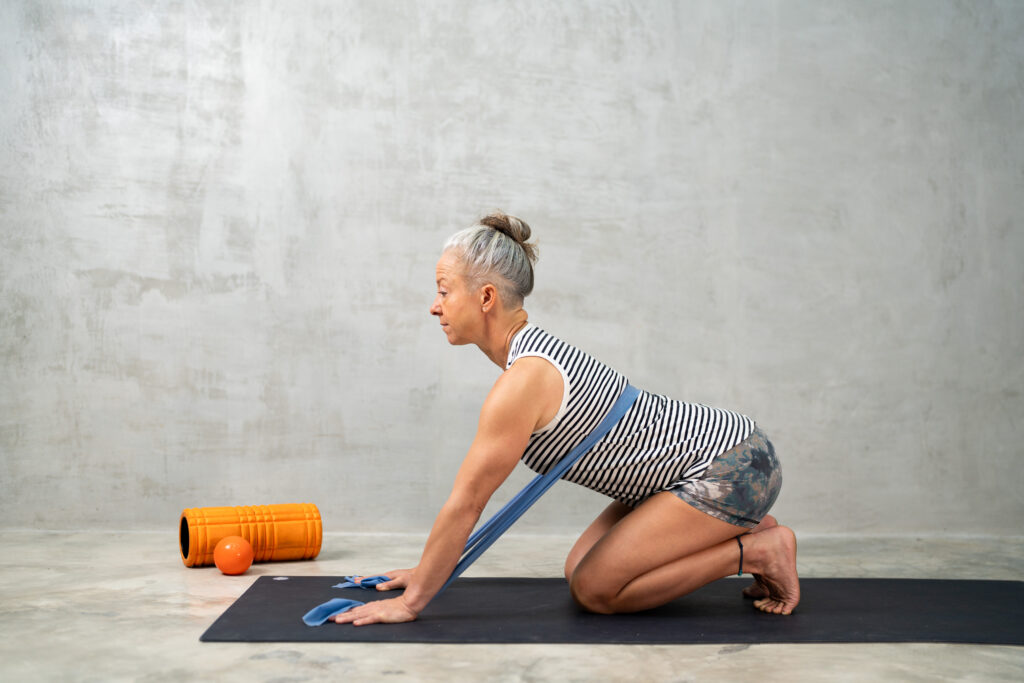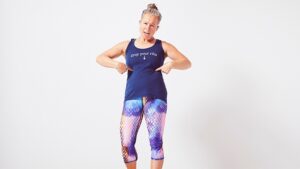UPDATED: April 16, 2025
Let’s face it – back pain sucks. Sadly, it’s also suuuuuper widespread, very common and affects people of all ages. It’s estimated that every year, 15-20% of adults will deal with back pain and around 50-80% will suffer from at least one episode of back pain during their lifetime. Despite advances in technology, effective treatments for back pain remain elusive and we’re no closer to having any concrete answers. However, it does seem like learning to move differently can help a lot – so let’s talk about back pain and movement!
Back Pain Isn’t The Same Thing As Tissue Damage
At any given time in the United States, 31 million people have low back pain. According to the World Health Organization, around 90% of LBP cases are non-specific (meaning it’s not possible to identify a specific disease or structural reason to explain the pain).
Pain is complex and multifactorial. Things like stress levels, social connections, beliefs about pain, how well you sleep, and all the other bazillion things that go into a human life can all affect how we perceive and experience pain.
Furthermore, structural damage to the body does not always cause pain (i.e. tissues can look damaged on an MRI but people report having no pain). And pain can occur without any structural damage (tissues look healthy on an MRI but individuals say they’re experiencing a lot of pain.)
In his book, Playing with Movement, Todd Hargrove writes, “one series of studies showed that ‘almost no matter where you point an MRI on a person over 30, you have a very strong chance of finding significant damage, even in places without pain’.”
When researchers studied MRIs of the backs of people without pain, they found that “about half had at least one bulging disc. The authors concluded that the presence of a bulging disc on someone with back pain ‘may frequently be coincidental.’”
Other research supports this conclusion:
👉 One study found that 1/3 of people without back pain had substantial spinal abnormality and 20% under the age of 60 had a herniated disc.
👉 A later analysis in 2015, which also examined the backs of people without pain, found that “by age 30, about half have disc degeneration. By age 60, about a quarter have spondylolisthesis (when a vertebra slips significantly forward from another). By age 70, more than three quarters have a bulging disc.” But – NONE of these people had any pain!!
In a follow up study seven years later, researchers discovered NO correlation between initial MRIs and future pain. They concluded that “baseline MRI findings cannot predict future back pain.” In fact, famous pain researcher Lorimer Moseley believes that getting MRIs for nonspecific back pain can actually do more harm than good.
In other words, the reason you have back pain may have nothing to do with what’s happening in your bones, joints or discs. This means you may want to consider treatment approaches that address stress, sleep or nutrition as well as or instead of movement. However, it also seems like movement is helpful for many people, we just don’t know exactly why.
(Side note: if you’re interested in learning more about pain, check out this fascinating Ted Talk from Lorimer Moseley – a professor, researcher and leading expert in the field of pain science).
So what’s the role of movement?
It seems likely that how we move or don’t move is part of what creates tissue damage. But if tissue damage isn’t necessarily what causes pain, then how does movement help (or harm) when it comes to back pain?
It’s actually not clear how movement affects back pain.
But what we do know is that avoiding movement is a bad idea. Approaches that endorse constant bracing, resting, or avoiding moving the spine entirely tend to encourage weakness and haven’t been shown to produce great long term outcomes.
Staying active and keeping moving is really important and is your best course of action if you’re struggling with back pain.
Moving supports the health of our tissues. And we’ve also found that learning to move in novel ways that help your brain feel safe & confident can potentially diminish pain (as well as allowing you to do more stuff).
That means exploring to find movements that you can do without pain (or with minimal pain), and build on those to become stronger & more functional.
So this post offers a movement ‘checklist’ for you to explore. See what resonates for you and explore with care!
This post isn’t intended to be medical advice – but it does offer some ideas to explore that have helped others address back pain.
Banish that stiff, creaky, achy joint feeling in just 10-15 minutes a day!
Movement For Back Pain Checklist
Below, you’ll find 13 key movement patterns that can have a big impact on back pain. Use this as your personal checklist – explore, ask what resonates and work on the pieces that stand out the most.
Disclaimer: the following is NOT medical advice. Always check with your medical provider before starting an exercise program.
Body alignment
How’s your alignment? We don’t want you to get stressed about your posture or feel like your spine needs to ‘always be in neutral’ – we want you to feel free to move smoothly and with control and ease. However, when your parts are positioned well relative to each other, you’re more likely to be able to move efficiently & effectively. How your parts relate to each other affects how your muscles function & the way that your body parts are loaded when you move. Just like poor alignment can wreck your tires, poor body alignment has a big impact as well! (Here’s a bit more on what body alignment means).
When it comes to back pain, I’d look at two main alignment considerations:
1️⃣ How your pelvis is aligned over your heels.
2️⃣ How your ribs align over your pelvis.
#1 How you stand: Hips over heels
Many of us stand with our pelvis pushed too far forward – hip joints way out over our feet instead of vertically lined up with the sides of our ankles (probably the result of many years in heeled shoes & chairs).
Standing with your pelvis forward compresses your low back (and also doesn’t do your feet, knees or pelvic floor any favours).
Here’s a side by side comparison of my pelvis pushed forward and my pelvis in a neutral position:

And here’s how to practice standing hips over heels so you become more comfortable keeping your pelvis in a neutral position.
Important note: one other thing to consider when it comes to the position of your pelvis – footwear. It’s impossible to stand with a neutral pelvis when you’re wearing shoes with heels (and I don’t just mean high heels. Almost all conventional shoes – yes even your sneakers!! – have a heel lift that will force your pelvis out of alignment. If you’re serious about working on body alignment to relieve back pain, check out this post I wrote all about safety transitioning to minimal shoes.)
#2 How you hold your ribcage
Just like many of us stand hips forward of heels, many of us also spend a lot of time with our ribcage held in a ‘rotated up’ position. Our lower ribs come forward as our upper ribs go back. This looks like ‘good posture’ – because we don’t want to be slumping forward either. But unfortunately it’s a posture ‘fix’ that creates more problems than it solves, by overusing a small number of joints in our mid-back to create the look of a ‘straight back’.
Ribcage lifting mis-aligns the core muscles, squishes our diaphragm and compresses our mid-back (I personally had a huge rib lifting habit before I discovered movement work – and a ton of tightness in my mid back as well).
Here’s a comparison of a lifted ribcage position and an aligned ribcage:
(If you want to learn more about why ribcage position is so important, get help doing a quick self-check of your own ribcage alignment and figure out your ideal ribcage position, make sure to pick up my free 5 part video series, Ribcage Magic right here!)
#3 How you sit
Most of us slump back and relax when we’re sitting, allowing our pelvis to ‘tuck’ into a deep posterior tilt. Sure, it feels great for a while, but when sitting with a tucked pelvis becomes a habitual pattern, it puts a lot of stress on the lower back.
The better option is to sit with a ‘neutral’ pelvis. This position uses more deep core muscles and loads the pelvis (sit bones) instead of the tailbone. Check out the video below for instructions on how to find a neutral pelvis while sitting.
Being Sedentary
Just as important as the way you sit is how long you spend sitting. Bodies need to move – and that includes our low backs and the muscles that affect them, like the core & hips.
#4 Take frequent movement breaks
Even though long periods of sitting are a staple of modern society, they just aren’t a good idea. More and more evidence shows that prolonged sitting is hazardous to our health, even if you’re regularly exercising. For example, inflammation starts to build up in our muscles after only 10-15 minutes of stillness – and we know that chronic inflammation can be a trigger for chronic pain.
The good news is that taking movement breaks can counteract the effects of long term sitting. A 2023 study done at Columbia University tested 5 different movement breaks (also called “exercise snacks”) to figure out the least amount of activity you need to do to counteract the health impact of sitting all day at work. The answer might surprise you. By walking just 5 minutes every 30 minutes the study’s participants significantly lowered both their blood sugar and blood pressure. Researchers also measured the participants’ mood, fatigue and cognitive performance and found that the movement breaks “led to significant decreases in fatigue and significant improvements in mood.”
So if you have to sit a lot, try adding frequent movement breaks and see if they help! Go for a walk, do some stretches, get creative!
#5 Switch up your sitting
Also, don’t hesitate to add variety! Change your living space to give yourself more movement options, for both work time and down time.
Build yourself a standing workstation – and keep it dynamic by having some movement equipment near at hand.
And try some floor-sitting time as well. Sitting on the floor without support for your back requires more core activation and muscle use – as well as providing instant movement variety and promoting hip mobility (which can itself help with back pain). Click here to learn more about floor sitting & how to get started.
Joint Mobility
Joint mobility underpins all movement in our bodies. Each joint needs to be able to play its part in how we move. Each joint should move well (and often) and have the range of motion to do its own job. An undermoved joint is usually unhealthy (because joints get fed & cleaned from moving), and an overmoved joint can get overloaded and stressed. Meanwhile a joint that lacks range of motion will force other joints to move too much in order to compensate.
Unfortunately because we don’t move often or with enough variety, many of us end up having lots of sticky under-moving joints, and a few super mobile ones that have to do all the work. The result can impact how our bodies feel – including our spines.
The good news is that this means we have a big opportunity to improve our joint mobility, which often means less pain and healthier joints. When it comes to back pain, the joints we most want to consider are the spine (of course!), but also the shoulders & hips (although rib mobility & shoulder blade mobility can also be important).
Banish that stiff, creaky, achy joint feeling in just 10-15 minutes a day!
#6 Spinal mobility
Your spine is made of 33 vertebrae, all of which should contribute when you move your spine. But most of us have some really sticky spots that don’t articulate well – and other spots that move too much.
For many of us, this means our upper back doesn’t extend much, our lower back doesn’t flex well and our mid-back is hypermobile (which is what my Ribcage Magic series will help you with).
So restoring the mobility of every spinal segment (and then actually moving your spine regularly) makes a ton of sense from the point of view of spinal function and the health of your spinal tissues. Anecdotally, many people report that this is a true game changer in how their back feels.
You can start gently improving your spinal mobility with 3 of my favourite exercises in the video below (make sure to grab a pull-up band and a foam roller!)
#7 Shoulder mobility
Our shoulders are another really sticky spot for many of us. When our shoulders have a limited range of motion, it’s usually our spine that compensates. This isn’t the best for our shoulders OR our spines – it’s better to spread the work around!
This means that improving your shoulder mobility can help alleviate back pain (and is great for your shoulders at the same time).
If you want to check whether your shoulder mobility might be impacting your spine, grab my free Ribcage Magic series. You’ll be able to tell whether lifting your arm overhead is actually coming from your spine.
#8 Hip mobility
Just like your shoulders, your hips can get sticky. And just like shoulders, your spine will often compensate for sticky hips.
Tight hips mean your spine moves extra during activities like walking, running or bending. I’m pretty sure your spine doesn’t appreciate doing the job of your hips.
The more hip mobility we have, the less we need to use our spines to compensate!.
Want to test how your hip mobility might be affecting your spine? Try out the lunge in this video to observe what compensation patterns you might be using every day without knowing it. (As a nice bonus, this lunge will also help you mobilize your hips for less of those same compensations during walking. For more info about walking & low back pain, check out the Walking Patterns section below).
Breathing & Core Patterns
Our breathing patterns, our core muscle function, and our spine are all deeply connected.
Just for a start, the respiratory diaphragm – our main breathing muscle – is literally attached to our spine. Plus, how we breathe and engage our core can – or can not – create pressure, stability and decompression in the low back area. Many people find that working on breathing & core function has a positive impact on how their backs feel.
So in this section, we’ll look at ways of breathing and core engagement strategies that you can explore.
#9 Breathing
In order to inhale, we create an area of lower pressure in our bodies. If you imagine that your trunk is like a can of coke, you can increase the space in your can in three ways.
You can drop the bottom of the can (belly breathing), you can lift the top of the can (upper chest breathing) or you can expand the sides of your can (360 degree ribcage breathing).
Many of us default to an upper chest or belly breathing pattern, often because our chest & shoulders are so tight & the back of our ribcage is compressed from a ribcage lifting habit. This is one reason it’s so essential to make sure you’re not constantly (and inadvertently) lifting your ribcage!
However, it’s the 360 degree ribcage pattern that seems to offer the best combination of decompression & stability for our spines. Many people find that simply working on their breathing can make a huge difference to back pain – here’s what to try:
Core engagement patterns
Core muscles should provide support & stability to the spine – a crucial role, especially during activities that put a lot of force on the low back (like lifting and high-speed bending or rotating). And ideally they should do this without us having to think about it!! However, many of us struggle with core strength or patterns. Here’s what to think about:
#10 Constant bracing
People with back pain are often taught to constantly brace their core muscles. This can work well as a temporary measure to decrease pain. But as a long term strategy, it’s immobilizing. Constant immobility leads to weakness and vulnerability. That means, core bracing is best used like an orthotic – a temporary fix to provide relief until you learn new ways to strengthen & move your core. If you’ve been bracing your core for a long time without feeling any change, it’s time to move on – learn to relax the bracing as your first step (see below).
#11 Sucking in
Another core pattern I see alllll the time is sucking in your stomach. Not only does this weaken our pelvic floors, upset our digestion and generally mess up everything that’s happening from our necks down to our pelvis, but it severely impacts how our core muscles function. If you want healthy core muscles that support a happy spine, this is an obvious pattern to work on.
So before you work on strengthening your core, learn to relax it! Here’s how:
#12 Make sure your core is providing functional support
Once you’ve relaxed your ribs down and let go of unhelpful core habits like sucking in & constant bracing, what’s next? You may find you need to re-pattern your core function (especially if you’re experiencing pelvic floor issues along with low back stuff).
This is a bit more complicated than I can share in a single blog post – but I have a whole course that will help! My Pelvic Floor+ program was designed as a whole body approach to pelvic floor issues and you’ll find a deep dive into core function (as well as breathing mechanics, spine & shoulder mobility and a whole lot of other stuff that will help your back pain).
#13 Walking Patterns
Ironically, the way we walk may be one of the patterns where we inadvertently create a lot of unhelpful mechanical stress on our spines.
Our bodies have adapted to a lifetime spent sitting, wearing shoes with heels and not moving enough by shortening some muscles and lengthening others.
This means we’ve lost the ability to extend our legs behind us when we walk (those sticky hips again!). This can force the spine to compensate on every step (usually with rotation & hyperextension). It also means we basically fall forward every time we take a step, which kind of means mini-whiplash with every step.
This means we really need to be able to get our legs behind us if we want to walk in a way that nurtures our spines. Here’s a few things to consider:
1️⃣ Hip mobility – clearly! The lunge I linked to earlier is a great start for hip mobility, and the hip CARs I teach in my Joints for Life program are also a really excellent option.
2️⃣ Big toe mobility: your big toe is a key part of getting your leg behind you. It has to have about 45-65 degrees of extension – if not, then your hips or spine are going to have to compensate. Try the big toe mobility exercises in my free Free Your Feet program you can pick up right here.
3️⃣ Tight calves: lots of time sitting in chairs & wearing positive heeled footwear = tight calves. Regularly stretching your calves can decrease tightness in this area and create more length & range in the backs of your legs. This reduces the amount you pitch forward when you walk, meaning less compensations in your lower back! This video walks you through my fave calf stretch option.
This should get you started – but you may also want to consider your footwear. Wearing shoes with raised heels will affect your gait and force you into that constant falling pattern. Switching to zero drop shoes is a key to creating a healthier walking gait! Check out this blog post to learn more.
Other Considerations: Novelty, Strength & Osteoporosis
When it comes to movement for treating low back pain, there are few concrete answers. But here are a few other key considerations.
Novelty
Our bodies and brains seem to crave variety. There are all kinds of creative ways to move and just doing new stuff seems to help with pain. Not to mention the fact that the more ways you move, the more strength & health-enhancing movement inputs you’re giving to your body. My Pelvic Floor + program has all kinds of gentle movements you can explore that will support healthy spinal function & alignment.
Strength
When you have a persistent sense of back ‘tightness’ it’s often tempting to focus on stretching, releasing & manual therapy. However, this is often a mistake. Our nervous system will tighten up muscles as a protective mechanism. Frequent stretching can provide temporary relief but may end up creating more threat for our brains & bodies. Instead, consider doing less stretching and instead focus on strengthening work for your back & core. Isometrics (muscle contractions without creating movement) have been shown to produce a pain-killing effect, so I’d probably start there within a pain-free range of motion. As your range and strength improves, you can progress to more loaded activities. The segmented cat-cow and other spinal mobility work I teach in my Joints For Life program are also excellent for foundational joint strength.
Bone density
If you have lower bone density, you’ll need to learn to modify or avoid some spinal movements because there’s a risk of fracture. However, it’s still really important to keep moving if you do have osteopenia or osteoporosis. My best advice is to inform yourself about how to move safely and work directly with a bone density educated teacher. This isn’t my area of expertise but I can highly recommend my friend Alison Crouch at MoveSmart.
Movement For Back Pain Checklist
Low back pain is tricky, complex and there’s no single answer or set of exercises that definitively solves the problem. There’s also a lot of conflicting info and differing opinions about what the best approach is. What we do know is that learning to move in novel ways and making movement changes can be really helpful and it’s worth taking the time to explore them in your body. Don’t be scared to move in new ways!
Ok – sounds great but where do I start??!! I recommend using the information in this post as a checklist. Begin by asking yourself, “What’s the biggest thing that’s missing here?” and start working on that.
Here’s a quick recap. If you answer ‘no’ to any of these questions, consider exploring it further with movement & mobility work!
#1 Do you mostly stand with your hips aligned vertically over your heels?
#2 Is your ribcage mostly relaxed down as you move through your day?
#3 When you sit, do you sit with a neutral pelvis?
#4-5 Do you take frequent movement breaks & vary the way you sit or stand throughout your day?
#6 Are you able to move your spine segmentally through all its segments?
#7 Are you able to flex your shoulders above your head without moving your spine?
#8 Do you have good hip mobility in flexion, extension & rotation?
#9 Do you mostly default to a 360 degree breathing pattern?
#10-12 When at rest, are your core muscles mostly relaxed, neither constantly sucked in nor constantly braced?
#13 Do you walk with some amount of hip extension (created from hip mobility, big toe mobility, and supple calves & hamstrings)?
And yes, I know this is a lot – but the good news is that working on any of these body skills will deliver benefits that go beyond your spine.
If that list didn’t help & you’re not sure where to start, I recommend prioritizing spinal mobility. I just added a brand new spinal mobility section to my Joints for Life program you’ll definitely want to check out. Plus, you’ll also work on mobility in your shoulders & hips!
The most important thing to remember is that back pain will pass. Lorimer Mosely believes it’s important to respect your pain but you definitely don’t want to fear it. Start by adding a few new movements into your daily routine (such as the CARs in Joints for Life). Go slowly & mindfully, respecting your body, and see how it goes. As your back pain starts to improve you can gradually increase your activity.
Now – time to get moving!
Banish that stiff, creaky, achy joint feeling in just 10-15 minutes a day!
Learn a simple head-to-toe daily routine that will keep your joints moving better & feeling better every day of your life.







